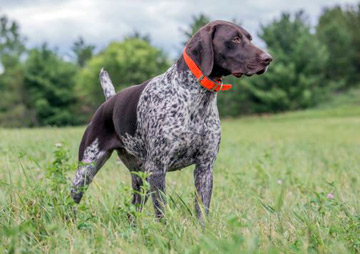 The most talked about new method of training dogs is crate training. More and more dog owners and their pets are learning the benefits of starting puppies on crate training as soon as they arrive in their new home. Crate training is the use of a plastic airline crate or a wire cage to confine a puppy when the family is not home or is unable to supervise the puppy’s activities. The crate in effect, becomes the puppy’s bed. Other terms used interchangeably with crate training are den and kennel.
The most talked about new method of training dogs is crate training. More and more dog owners and their pets are learning the benefits of starting puppies on crate training as soon as they arrive in their new home. Crate training is the use of a plastic airline crate or a wire cage to confine a puppy when the family is not home or is unable to supervise the puppy’s activities. The crate in effect, becomes the puppy’s bed. Other terms used interchangeably with crate training are den and kennel.
You may feel that it is cruel to confine a dog to a crate. It would be cruel to just close him in the crate and leave. But if you introduce him to the crate properly, you will find that your puppy will quickly come to prefer it for sleeping and quiet time. Too many dogs are surrendered to animal shelters because of the damage done while they are unattended. Since over 85% of these puppies are euthanized, it is kind, NOT cruel, to crate train a puppy to prevent behavioral and housebreaking problems.
Why Crate Train?
Dogs in the wild live in dens. The den provides wild dogs protection from predators as well as the elements, and it allows for a feeling of security. That’s why you often find dogs curling up under a table, chair, or bed. By giving dogs a secure place that is all their own, pet owners can take advantage of a dogs’ natural instincts to help the dog feel safe, thus reducing isolation-induced stress.
 Crate training, if done properly, is a wonderful training tool with many benefits. Apart from the obvious uses for transporting dogs, a crate can be used for short-term confinement — to keep your puppy out of mischief so he does not develop bad habits when you cannot give him your undivided attention.
Crate training, if done properly, is a wonderful training tool with many benefits. Apart from the obvious uses for transporting dogs, a crate can be used for short-term confinement — to keep your puppy out of mischief so he does not develop bad habits when you cannot give him your undivided attention.
A crate can also be used to develop good habits –to house train your puppy, to establish a chew-toy habit, and to reduce inappropriate barking and digging. Also, if your dog ever injures himself or becomes ill, the crate will be invaluable during recovery. If you move, your dog’s adjustment to a new home will be quicker and less stressful if he is crate trained. If you stay in motels or visit relatives, your dog will be “damage-proof” if he travels with his crate. If you travel by car, placing the dog in the crate will keep him out from under your feet, away from the driver, and more safe in case of an accident.
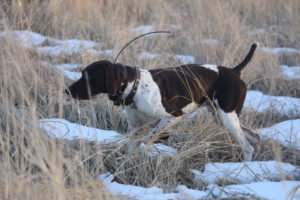 Who Should Crate Train?
Who Should Crate Train?
Owners of new puppies and any adult dogs with destruction and/or housebreaking problems should crate train. The only time crate training would not be advisable is in a situation where a puppy will be left alone for an extended period of time and a family member cannot come home to let the puppy out during the day.
It is a dog’s natural instinct to keep his crate/home clean, so he will “hold it” as long as he can before eliminating in the crate. The maximum time an 8 week old puppy should be in his crate without a break is 4 hours. Puppies younger than 8 weeks have to “go” about every 2-3 hours so they should be given a crate-break at those intervals. Except for overnight sleeping, crate confinement approaching 8 hours is strongly discouraged. As the puppy gets older (4-6 months) you can gradually leave him in his crate for longer periods of time, but you should never exceed 8 hours for any dog.
If a family member is unable to come home midday to let the puppy out, there are a couple of alternatives. The most desirable would be for a pet-sitter, relative, or neighbor to come by the house and let the puppy out while he is young. If this is not an option, leave the puppy in a confined area with his crate with the crate door open. This way he can sleep in the crate and come out of his crate to use the bathroom. A collapsible wire barrier called an “exercise pen” (or X-pen) can be used to create a damage proof, safe inside area or a small bathroom can be used. However, using this type of set-up will lengthen the housebreaking process because the puppy will be learning to eliminate in the house. Also, some puppies can quickly learn to climb out of the X-pen.
When Should You Crate Train?
Owners of all age puppies and dogs can start crate training at any time. It is best to start puppies immediately, so they do not have the opportunity to develop bad habits. Most adult dogs can be taught to like using their crates if they are introduced to it properly. In most cases, it will take an adult dog longer to adjust to a crate than it will a puppy.
The key is to let the dog get comfortable going in and out of the crate on his own. Never force the dog into the crate. To get your canine interested in the crate, you can put his food dish inside so he has to go in to eat. Also, you can make going in the crate a game by throwing treats or his favorite toy inside for the dog to retrieve.s rewarding –even reprimands.
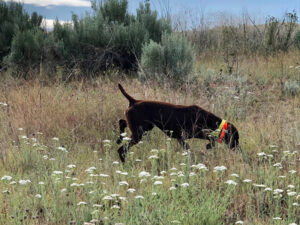 When Should You Crate Train?
When Should You Crate Train?
Owners of all age puppies and dogs can start crate training at any time. It is best to start puppies immediately, so they do not have the opportunity to develop bad habits. Most adult dogs can be taught to like using their crates if they are introduced to it properly. In most cases, it will take an adult dog longer to adjust to a crate than it will a puppy.
The key is to let the dog get comfortable going in and out of the crate on his own. Never force the dog into the crate. To get your canine interested in the crate, you can put his food dish inside so he has to go in to eat. Also, you can make going in the crate a game by throwing treats or his favorite toy inside for the dog to retrieve.
What Size/Type Crate?
Size: The ideal situation for housebreaking is to use a size crate that is 2 times the puppy’s body length and big enough for the puppy to stand-up, turn around, and lie down in.
However, for most people, it is not feasible to purchase new crates as the puppy grows. The best alternative is to buy a crate that will be large enough for your dog when he grows up. As an adult, the dog should be able to lie down comfortable on his side as well as stand, sit, and turn around without difficulty.
For housebreaking a puppy, the crate should can be made smaller by using a partition (made of a safe substance) or a divider panel to limit space. If the puppy has too much room, he will eliminate in one area of the crate and sleep in another, thus increasing the time it takes to house train the puppy.
Type: There are two basic types of crates: a plastic “airline kennel” and a wire cage. Each has certain advantages. The plastic crates are usually more portable than wire cages and are more “cozy” for the animal, while wire cages typically have more width and height space than plastic cages of approximately the same size. The angled design of the plastic crates makes their width at the base more narrow than the box design of wire cages.
You can buy wire cages that are easily collapsible and can be carried like a suitcase, which is helpful when traveling. Most wire cages have removable pans that can slide out for easy cleaning. If you select a wire cage, cover the back completely and top and sides 1/2 way down with a towel to create a den-like atmosphere. If you do not cover a portion of the cage, the dog may not feel safe and secure because of the openness of the cage.
Plastic crates and wire cages are available at most pet stores and by mail order from companies such as wholesaler R. C. Steele 800.872.3773 and Doctors Foster & Smith 800.826.7206.
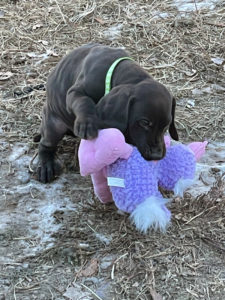 Where Do You Put The Crate?
Where Do You Put The Crate?
Dogs are pack animals and prefer to be with their pack/family, so keep the crate in a lived-in part of the house. A bedroom, kitchen or family room is good — never a garage or unused basement!
When the puppy is young it is recommended to have the crate near the door he will be going out to use the bathroom. Having the crate close to the door will help prevent any elimination accidents as the puppy leaves his crate and heads for the door to go out.
How Do You Crate Train?
Your dog should thoroughly enjoy spending time in his crate. This can be accomplished by introducing him to the crate properly, making it comfortable and fun to go into the crate, and by giving him something entertaining to do in the crate. Below is a step-by-step outline of the recommended process:
Set Up
1. Set up the crate with the puppy out of the room, so as not to startle him.
2. Use old blankets, towels or sheets as bedding. Do not make the bedding material too absorbent because the puppy needs to be severely inconvenienced if he urinates in his crate. Note: Many puppies will chew bedding which can be very dangerous so take time to observe if he is trying to chew his bedding.
3. DO NOT use housebreaking pads in the crate because this will attract and encourage the puppy to eliminate in his crate.
4. DO NOT put a water bowl in the crate because it will spill and wet the bedding.
5. DO put one or two safe chew toys in the crate with the puppy so he has something to occupy his time — a Tuffy Kong toy is one of the best and safest toys to leave a puppy alone with. Stuffing a Kong toy with freeze-dried liver or a biscuit can keep the puppy
entertained. Note: Do not leave a puppy alone with a toy that can splinter or break off in small pieces, such as rib bones and rawhide bones. These are chew toys that should be supervised as they may cause the puppy to choke.
6. If you are using a wire crate, place an old blanket or sheet over the top and sides in order to create a den-like atmosphere. Tuck the ends of the covering under the crate so that the puppy cannot pull them inside to chew on them.
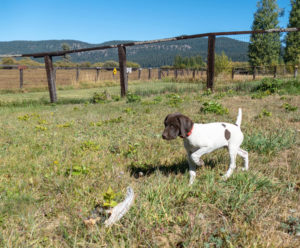 Introduction and Use of the Crate
Introduction and Use of the Crate
1. When it is time for the puppy’s meal, place the bowl just inside of the crate so the puppy has to stick his head into the crate to eat.
2. Between feedings, you can make going into the crate a game by tossing in treats or toys. Allow your puppy to come and go at will –do not force your puppy into the crate.
3. When the puppy gets in the crate on his own or because there is a treat inside, this is your cue to start associating a command with the action. You can use statements such as “kennel up” or “go to bed.” The most important thing to remember in giving commands is to be brief and consistent.
4. Always leave the crate door open when your puppy is out of the crate so he can get in it when he wants.
5. When you are home, make going into the crate a game. Give your chosen command, such as “go to bed,” and throw a treat or toy into the crate. Let your puppy walk in and out of the crate at will. Whenever your puppy goes into the crate on his own, lavish him with praise!
6. Each time the puppy enters his crate for confinement, give him a tasty treat such as Bil-Jac Liver Treats, jerky treats, cat treats, or a small piece of hot dog or cheese.
7. ALWAYS use your chosen command when calling your dog to the crate for confinement. DO NOT simply call him to you, as he may become wary of approaching you when called.
8. NEVER USE THE CRATE AS PUNISHMENT! Your dog will pick up “vibes” from you if you put him in the crate when you are angry. The puppy’s crate should be his secure place. It should not be associated with punishment, fear, or anything negative. If you treat the crate as a wonderful, gentle, lifesaving tool to prevent accidents, destruction, and behavior problems, your puppy will feel positive about the crate too.
9. Every time you let the puppy out of his crate, even if he has only been confined 30 minutes, take him straight outside to his “potty” area and give him your command such as “go potty” or “hurry up.” Praise him when he eliminates outside. If the puppy does not eliminate within five minutes and you know it is time for him to do so, put him back in the crate. Wait approximately 30 minutes and then take him outside again. In the morning, be sure to take the puppy out the minute he starts to fuss.
 10. If the puppy eliminates in his crate, clean it up immediately and thoroughly. After cleaning up the urine, wipe the bottom of the crate with a pet odor eliminating product or a solution of vinegar and water. It is necessary to clean up the odor completely so the puppy does not smell it later and urinate there again.
10. If the puppy eliminates in his crate, clean it up immediately and thoroughly. After cleaning up the urine, wipe the bottom of the crate with a pet odor eliminating product or a solution of vinegar and water. It is necessary to clean up the odor completely so the puppy does not smell it later and urinate there again.
11. During all unsupervised times, the puppy should be in his crate with the door closed. Normal, healthy puppies will generally get into mischief if unattended. The tendency of puppies to “learn” about their surroundings is too strong for them to control –learning means chewing, scratching, and digging. If the puppy is unable to get into trouble, destructive habits will not be formed.
12. As your puppy gets older (probably close to 1 year old), you can start leaving him out of the crate unattended for short periods of time. When you first leave him unattended and out of the crate, restrict him to one or two rooms in the house. If the puppy behaves in your absence, gradually increase his time out of the crate with the ultimate goal being never having to close him in his crate. However, he should continue to have access to his crate whenever he wants. If the puppy gets into mischief in your absence, begin to crate him again whenever he is unsupervised and try again later.
 When Problems Arise
When Problems Arise
Elimination in the Crate could be due to a number of causes:
Was the puppy crated longer than he was able to “hold it”?
Did the puppy drink an excessive amount of water before he was crated?
Did you take him outside and give him a chance to eliminate before he was crated?
Is the crate too big, enabling the puppy to get away from his mess?
Is the bedding material too absorbing his mess so he is not severely inconvenienced when he urinates in the crate?
Never rule out medical problems when your pet’s habits seem to change. Some dogs and breeds are easier to crate train than others, so keep trying and do not get discouraged if there are occasional mess-ups.
Barking in the Crate: Puppies may bark when they are first put in the crate. In most cases, if you ignore the barking, the puppy will stop because he is not getting what he wants — attention. Do not allow family members let the puppy out of the crate when he barks. If you do, you run the risk of training him to bark so he will be let out.
If the barking persists over days or weeks, you can try covering the entire crate with a blanket or sheet. Try this method for a few days to see if it reduces the puppy’s barking. You can also try leaving a radio playing to mask sounds and keep the puppy company when you are away. Surprisingly, yelling “be quiet” at a barking dog may actually reinforce its barking behavior. For many dogs any type of attention is rewarding –even reprimands.